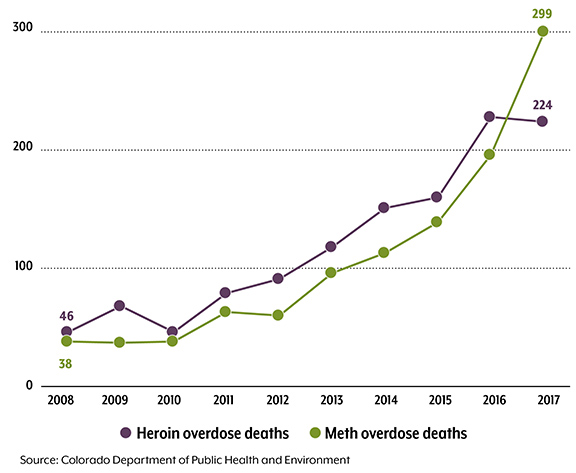On International Overdose Awareness Day, Learn from the Past and Look Toward the Future
August 31 is International Overdose Awareness Day: a day to remember those who who’ve lost their lives as a result of a drug overdose, reflect on efforts to address the issue, and advance policies to prevent more from dying in the future.
Colorado has lost 1,012 people to drug overdose in 2017 alone. That means some 17.6 people per 100,000 residents died due to a drug overdose in 2017, up from 16.1 per 100,000 in 2016 and just 12.6 per 100,000 in 2006, according to the Colorado Department of Public Health and Environment.
Much attention has been – and will continue to be – focused on the toll of the opioid epidemic. And rightfully so. Deaths from prescription painkillers and heroin have rapidly climbed in recent years, with the 2017 numbers for these two categories combined reaching 560 lives lost. Our state has made significant efforts to slow the trend. Colorado lawmakers have passed legislation embracing harm reduction solutions like Narcan, the state has received millions in federal funding to expand access to medication assisted treatment, and communities across the state have brought together their own opioid-related task forces.
We should continue talking about opioids. As the numbers show, the epidemic continues in Colorado despite our best efforts. But if we are going to make a dent in the number of drug overdose deaths in Colorado, we need to look at the trend line that is close behind that of opioid deaths: methamphetamine.
Methamphetamine – meth for short – overdoses in Colorado have increased from 38 just a decade ago to 299 in 2017. This means that in 2017, for the first time in a decade, more Coloradans died from a meth overdose than a heroin overdose.

Meth overdose deaths have quickly increased in the past five years, but the impact of the drug has long been in the public eye. Coloradans may remember the Faces of Meth Campaign, which made its rounds on the internet in the 2000s. The graphic pictures showed meth’s physical toll on the body, depicting faces marked with scabs and sunken features. Meth had another moment in the spotlight with Breaking Bad, a popular television show about a high school chemistry teacher who turns to making meth that aired between 2008 and 2013.
The image of domestic meth labs depicted in Breaking Bad is not obsolete, but it was more accurate in the early 2000s than today. Policies were put in place to limit over-the-counter sales of pseudoephedrine – an ingredient found in Sudafed and used to make meth. This resulted in fewer domestic meth labs, but an increase in meth coming from drug cartels. This mass-produced meth is increasingly cheap and potent.
Our approach to methamphetamine overdoses will require different tactics than those the state has taken to combat the opioid epidemic. Though trials are underway, medication-assisted treatment has not yet been successfully identified for meth use as it as for opioids. Narcan – the opiate overdose reversal drug – is not effective for this class of drugs.
Still, much of the infrastructure that Colorado has invested in as a result of the opioid epidemic will remain vital to making sure that the rapidly increasing meth overdose trend will begin to flatline and fall.
There is some overlap in deaths due to methamphetamine and opioids. In 2017, for instance, 79 deaths were reported to involve both heroin and meth, up from 25 in 2015.
Treatment admissions for those who use meth increased 34 percent from 2008 to 2015. As this trend continues and more Coloradans seek treatment, we need to ensure that the availability of services meets the demand. Investments in expanding treatment for substance use disorders – as well as efforts to bolster prevention and recovery – will continue to be needed.
And we’ll need to tap the partnerships and coalitions of first responders, family members, people in recovery, judges, nurses, law enforcement, and so many more that have formed as a result of the opioid epidemic to find solutions for people who are struggling with methamphetamines.
The substance of focus may change over time, but the underlying challenges of addiction remain the same. At CHI, we’ll continue our part of confronting the challenge by bringing you data and analysis on substance use and policies that are attempting to address it.
Find Tamara Keeney on Twitter: @tamjkeeney
Want more information about health and health policy in Colorado? Subscribe to our newsletter or find CHI on Facebook and Twitter
Related Blogs and Research
- More than 1,000 Coloradans Lost to Drug Overdoses in 2017
- Depicting 2017 Drug Overdose Rates
- Drug Overdoses in Colorado: A Statewide Challenge
- Research on Opioids
- Suicides in Colorado Reach All-Time High
